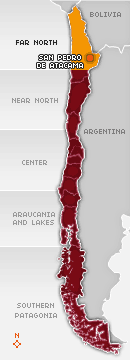Tours and Activities:
Wonderful Pink
Pablo Etchevers Pablo EtcheversTalking about flamingos inevitable leads us to refer to their original color, whose beauty makes them mysterious creatures calling the attention of people.

Natural Glamour
“The most female of all” would be the perfect title to define these creatures, which received the natural gift of a perfect charming gait - an image of irresistible glamour -as no other bird has on earth. Watching how they move on the salt deposits gives the lovers of birds and ornithologists a true feeling of completeness.
The Soncor and Chaxa Lagoons as well as the Cejas, Tebenquiche, Miscanti and Meñiques, Tara and Negra are some of the natural ecosystems where salt is the natural scenery and flamingos the great protagonists.
The Atacama Salt Deposit is just 40 kilometers away from the city, occupies an area of 320 thousand hectares and lies at over 2 thousand meters of height.

At first glance, it is possible to watch the famous salt crusts surprising and claiming the attention of the visitors who have never seen them, since their rhomboidal shapes seem to multiple until infinity. Real lagoons lay below them. The salt is produced from the evaporation of these lagoons, which mostly emerge from the surface with very few centimeters of water and are inhabited by small algae and microvertebrates which are the daily diet of flamingos and other birds.
Territorial Birds
Few flora species can grow in a salt deposit. In general, inland salt grass and other minor grass species are some of those which survive these climate conditions and the constant salt erosion. The same happens with birds, since many of them are affected by the salt level. We can find, among them, the Andean dull, caiti, fraser, harrier and Baird’s Sandpiper, and the three kinds of flamingos which deserve to be mentioned in a special chapter.

Phoenicoparrus andinus, Phoenicoparrus jamesi and Chilean Flamingo are the three types of birds that at first sight are very much alike. However, even though they belong to the same Phoenicopteridae family, they have distinguished features. One of the similar characteristic is related to the biological need to reproduce and, therefore, to find nesting opportunities where man cannot adversely affect their habits and behavior. Even though the Atacama people know them and have respected them for 11 thousand years, the present flamingo population has gradually decreased. Today, flamingos come from distant places and, in the last years, the Atacama salt deposit has been luckily receiving these pink creatures.

© 2007-2025 Total or partial reproduction forbidden. Derechos de Autor 675243 Ley 11723


 See also:
See also: 



